LED Display Module: The Ultimate Introduction Guide
Chinastar LED provides a wide range of LED Display Modules, including indoor, outdoor, flexible soft, and GOB LED Modules, all at factory prices. Each module undergoes rigorous testing with a 72-hour aging test to ensure high brightness, refresh rate, and grayscale, resulting in exceptional visual performance for LED displays.
This article offers comprehensive insights into LED display modules, the fundamental unit of LED displays, also known as LED panels.We will take you to learn more about LED display modules from what they are, how to install them, module application classifications, etc., and we will provide you with some suggestions.
Seek Solution?
Choose right LED display products for your projects
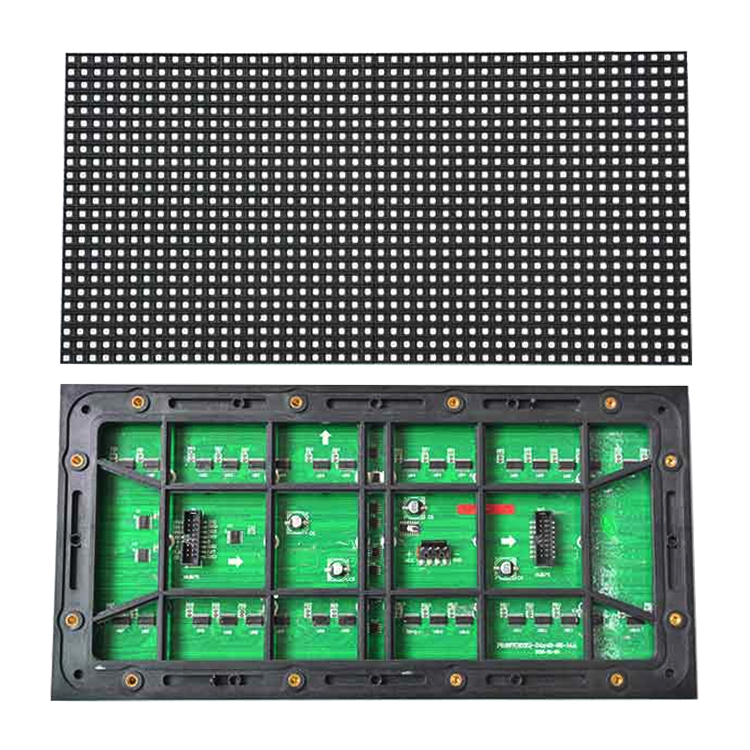

LM3.91
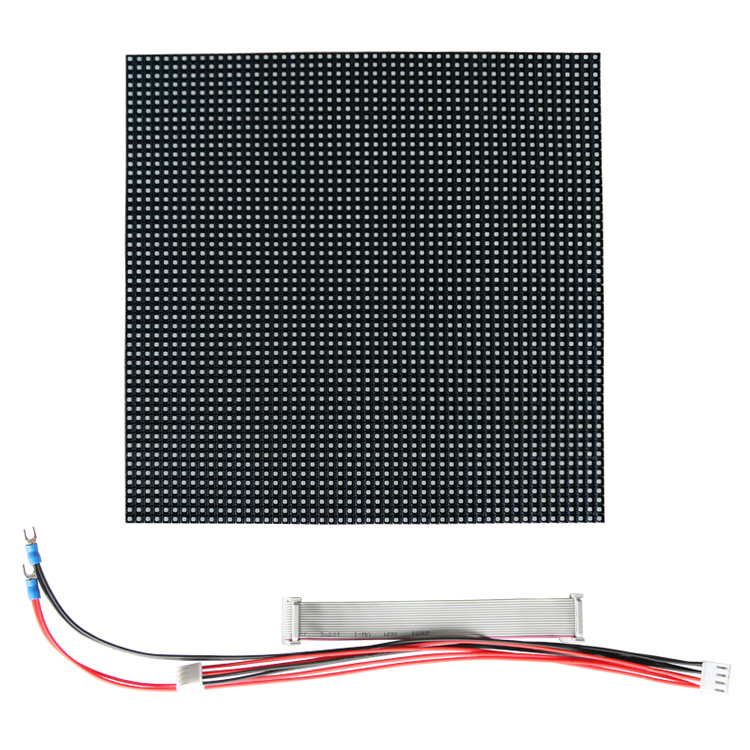
Currently, the LED module market is showing a steady growth trend, mainly benefiting from the popularity of digital advertising and the increasing indoor and outdoor applications. With the rise of digital marketing, enterprises have an increasing demand for LED displays, especially in fields such as retail, entertainment, sports, and transportation. The demand for LED modules has also grown as it is an essential component of LED displays and is used to build screens of various sizes and shapes.
At the same time, with the continuous innovation of technology and the reduction of costs, the performance and quality of LED modules continue to improve, further promoting the development of the market. In the future, with the acceleration of smart city construction and digital transformation, the LED module market is expected to continue to maintain growth momentum.
1.What Is LED Display Module?
2.Common Size of LED Module
3.LED Display Module Components
4.LED Display Module Classification
5.Three common types of LED Display Module
6.Why Do You Need LED Display Module?
7.Why Choose Chinastar LED Display Module?
8.Conclusion
1. What Is LED Display Module?
An LED display module, also known as an LED module, is a basic component of an LED display screen. It consists of a group of LED chips arranged in a certain pattern on a printed circuit board (PCB). The LED chips emit light when electric current passes through them, allowing the module to display images, videos, text, or other content.
LED display modules come in various sizes, shapes, and configurations, with different pixel pitches (the distance between the centers of adjacent pixels) and resolutions. They are typically designed to be modular, allowing them to be easily assembled into larger LED display screens of various sizes and shapes.
LED display modules are widely used in various applications, including indoor and outdoor advertising displays, stadium scoreboards, digital billboards, retail signage, information displays, and more. They offer advantages such as high brightness, energy efficiency, durability, and flexibility in creating dynamic and engaging visual content.
2. Common Size of LED Module
LED screen modules come in various sizes to suit different display requirements. Some common sizes include:
320*160mm: This size is commonly used for outdoor LED displays, offering a good balance between resolution and visibility.
250*250mm: This size is often used for indoor LED displays, providing versatility in different installation settings such as retail stores, corporate events, and exhibitions.
192*192mm: Another common size for indoor LED displays, offering high resolution suitable for applications where detailed content is essential, such as control rooms, broadcast studios, and command centers.
60*160mm: This size is often utilized for smaller LED displays, such as those found in transportation hubs, retail stores, and digital signage installations where space is limited but high resolution is still required. It offers a compact form factor while still providing sufficient resolution for clear and engaging content display.
320*320mm: This size is typically used for large-scale outdoor LED displays, providing excellent visibility and visual impact for advertising, sports events, and outdoor concerts.
3. LED Display Module Components
A typical LED display module comprises several key components essential for its operation:
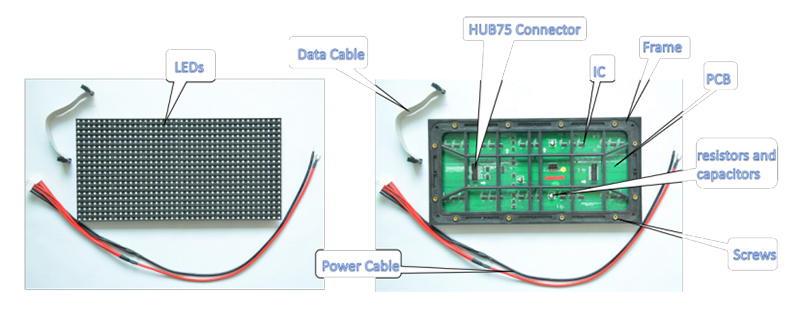
LED Chips: These are the individual light-emitting diodes (LEDs) responsible for producing light. They come in different colors (typically red, green, and blue) and are arranged in clusters to form pixels.
PCB (Printed Circuit Board): The PCB serves as the platform for mounting the LED chips and other electronic components. It provides the necessary electrical connections and pathways for the module’s functionality.
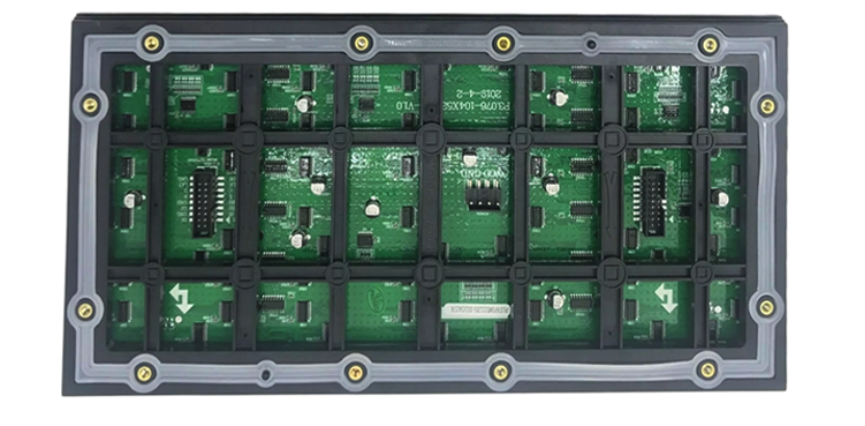
LED Lamp Beads: LED lamp beads are the core light-emitting elements of the module. They emit light when an electric current passes through them, producing colors based on their semiconductor materials. LED lamp beads come in different sizes, shapes, and specifications, with variations in brightness, color temperature, and viewing angle. These beads are arranged in clusters on the module’s PCB to form pixels, which collectively create the visual content displayed on the LED screen.
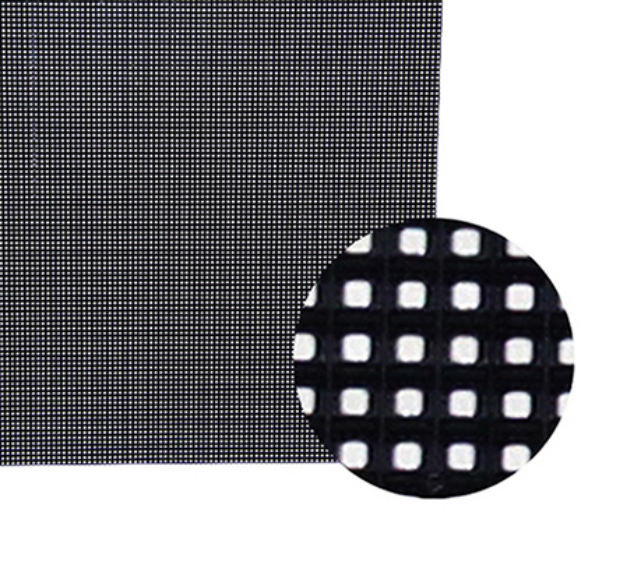
Driver ICs (Integrated Circuits): These ICs control the operation of the LED chips, regulating the brightness and color output. They interpret the incoming data signals and drive the LEDs accordingly.
Power Supply: LED modules require a power supply unit (PSU) to convert AC power from the mains into DC power suitable for the LEDs. The power supply ensures stable and reliable operation of the display.

These components work together to enable the LED display module to function effectively, producing vibrant and dynamic visual content for various applications.
4. LED Display Module Classification
Based on Pixel Pitch:
LED modules are often categorized based on their pixel pitch, which refers to the distance between individual pixels on the module. Common pixel pitch options include P2, P2.5, P3, P4, P5, P6, P8, P10, and more. Modules with smaller pixel pitches offer higher resolution and are suitable for close-viewing applications, while larger pixel pitches are ideal for outdoor and large-format displays.
2) Based on Application:
Indoor LED Modules: Designed for use in indoor environments such as retail stores, conference rooms, control rooms, and sports arenas. These modules typically have higher refresh rates and color accuracy for optimal indoor viewing experiences.
- Indoor led module Protection Grade: IP54.
- Indoor full color brightness 600-1,000cd/m2 .
- According to different requirement ,it can be 1920HZ~R3840HZ Refresh Rate.
- Indoor display module power consumption is very lower, the indoor natural ventilation and heat dissipation can be achieved.
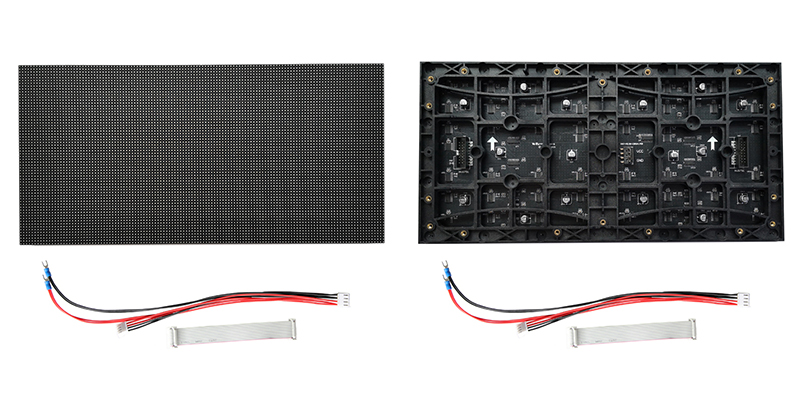
Outdoor LED Modules: Engineered to withstand outdoor conditions such as sunlight, moisture, and temperature variations. Outdoor modules are built with weatherproof materials and often feature higher brightness levels to ensure visibility in bright ambient light conditions.
- utdoor led module protection grade : IP65 or IP68 Waterproof outdoor led module.
- Brightness: outdoor full colour module 5,000-10,000cd/m2
- Refresh Rate: 960HZ-1920HZ Refresh Rate
- The power consumption of outdoor display module is large.the current temperature is higher, the power consumption is higher , it will cause the LED lamp life is shorter.
- Under the same brightness, the larger the distance between pixel pitch, the smaller the power consumption.
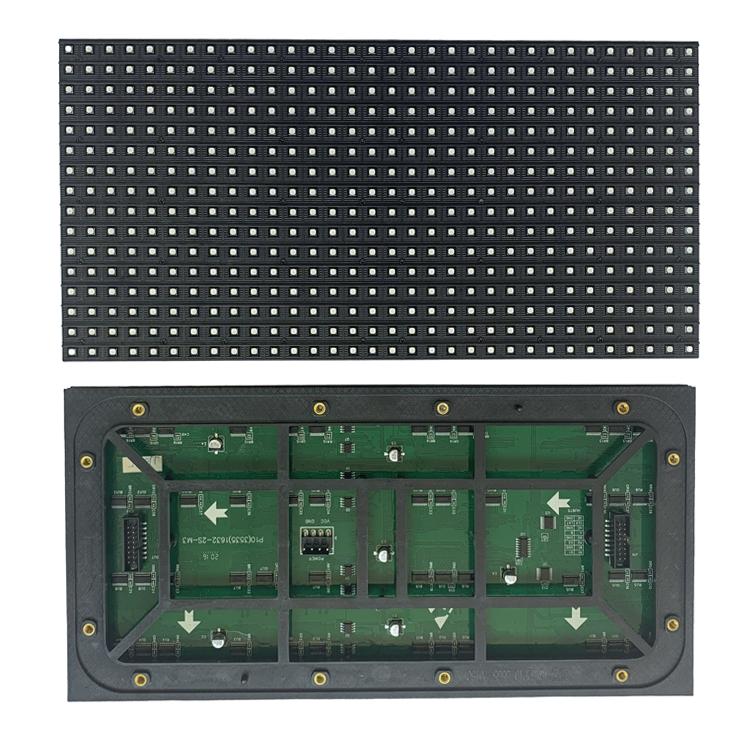
Flexible Soft LED Modules: Some LED modules are designed for specific applications such as transparent displays, curved displays, flexible displays, and creative-shaped displays. These modules incorporate unique features to meet the requirements of specialized installations.
- Compared with traditional modules, soft modules have good seismic resistance and anti-torsion capabilities, and can solve various transportation and installation problems.
- It can achieve special shapes such as bending and folding, adapting to various creative designs and installation scenarios.
- LED flexible module installation method is magnetic column adsorption, easy to install, can be spliced and combined freely, and maintenance cost is low
- Flexible LED display modules can be customized according to customer needs, including size, shape, pixel density, etc.
- Single point maintenance can be achieved, low maintenance cost, high brightness, low dead light rate, energy saving, seamless splicing.

3) Based on Construction:
LED modules can also be classified based on their construction, including aspects such as module size, thickness, weight, and mounting method. For example, modules may be available in standard sizes such as 320x160mm, 250x250mm, or custom sizes to fit specific display configurations. Additionally, modules may be designed for front serviceability or rear serviceability, depending on the ease of maintenance and installation requirements.
These classifications help you select the most suitable LED display modules based on their specific application needs, environment conditions, and display preferences.
DIP LEDs (Dual In-line Package LEDs): DIP LEDs are traditional through-hole LEDs characterized by their distinctive package with two parallel rows of pins. They are relatively large and robust, making them suitable for outdoor applications where durability is essential. DIP LEDs offer good heat dissipation and are often used in outdoor LED displays due to their high brightness and visibility, especially in direct sunlight.
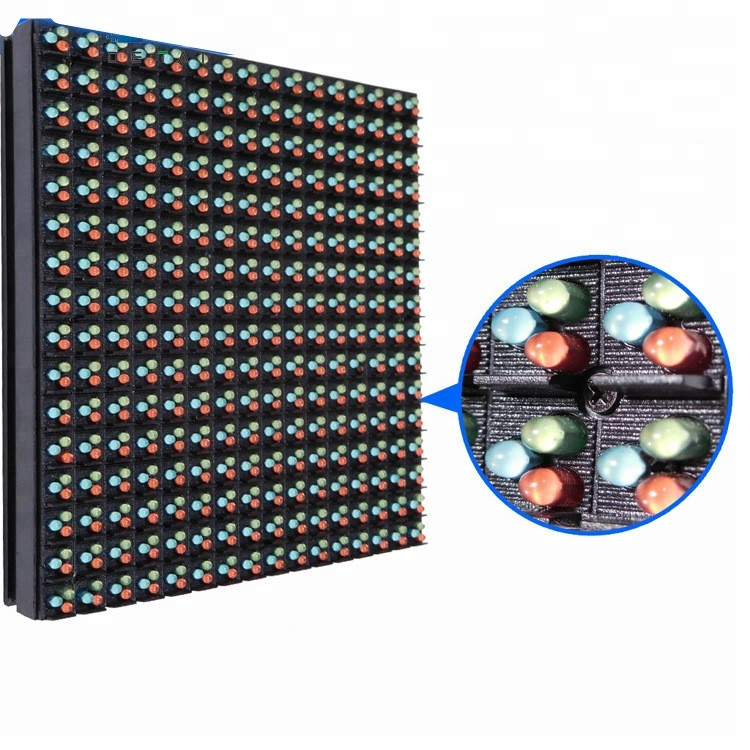
SMD LEDs (Surface-mount Device LEDs): SMD LEDs are smaller and more compact compared to DIP LEDs. They are surface-mounted directly onto the PCB without leads, allowing for higher pixel density and improved color consistency. SMD LEDs come in various sizes, such as 2121, 3528, and 5050, with each size offering different levels of brightness and color rendering. They are commonly used in indoor LED displays and applications requiring finer pixel pitches and higher resolution.
The main models include SMD1010, SMD2020, SMD2525, SMD2727 and SMD3535 (the name of model decided by size of lamp bead). Below LEDs pictures for your reference.

GOB LEDs (Glue-On-Board LEDs): GOB LEDs are a specialized type of SMD LED that features an additional epoxy resin layer encapsulating the LED chip. This encapsulation enhances protection against environmental factors like moisture, dust, and impact, making GOB LEDs ideal for outdoor and high-impact applications. The resin layer also improves thermal conductivity, ensuring efficient heat dissipation and prolonging LED lifespan. GOB LEDs are preferred for outdoor LED displays where ruggedness and reliability are paramount.
The Advantage of GOB LEDs is that GOB LEDs is hard to damage because of Glue protection. so some customers use GOB LED for Rental LED Display.
The Disadvantage of GOB LEDs is that GOB LED Module is hard to repair when the LED is broken, and the led module contrast is not good as the SMD LED Module.
6. Why Do You Need LED Display Module?
LED display modules serve as the building blocks of LED screens and displays(超链接到首页), playing a crucial role in delivering high-quality visuals for various applications. Here are several reasons why LED display modules are essential:
Modularity: LED display modules are modular components that can be easily assembled and arranged to create LED screens of different sizes and shapes. This modularity allows for flexibility in design and installation, making LED displays adaptable to diverse environments and requirements.
Scalability: LED display modules enable scalability, allowing users to expand or upgrade their LED displays by adding more modules as needed. This scalability is beneficial for applications where display size or resolution may need to be adjusted over time.
Maintenance: LED display modules simplify maintenance and troubleshooting processes. In the event of a malfunction or damage, individual modules can be easily replaced or repaired without affecting the entire display, minimizing downtime and maintenance costs.
Customization: LED display modules come in various sizes, pixel pitches, and specifications, providing options for customization based on specific application requirements. This customization capability ensures that LED displays can meet the unique needs of different environments, such as indoor or outdoor settings, high-resolution displays, or large-format screens.
Reliability: LED display modules are designed for durability and reliability, with features such as rugged construction, weatherproofing, and advanced heat dissipation technologies. These qualities ensure that LED displays can withstand harsh environmental conditions and continuous operation without compromising performance.
High-Quality Visuals: LED display modules incorporate advanced LED technologies to deliver high-quality visuals with vibrant colors, sharp contrast, and wide viewing angles. This ensures that content displayed on LED screens is visually engaging and impactful, whether it’s advertising, informational content, or entertainment media.
Overall, LED display modules are indispensable components in the construction of LED screens, providing versatility, scalability, and reliability for a wide range of applications across industries such as advertising, retail, entertainment, transportation, and more.
7. Why Choose Chinastar Indoor LED Display?

High quality LED parts
We have established close cooperation with suppliers such as Novastar, Kinglight, Nationstar, Colorlight, Meanwell, Macroblock, Mooncell etc. The industry’s first-class raw materials ensure that our products are stable and reliable.
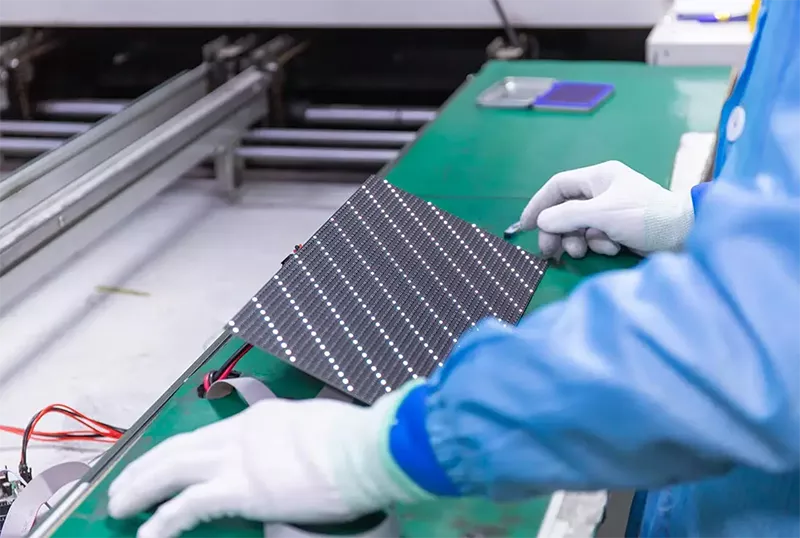
First-class workshop, professional workers
Chinastar has first-class automated production equipment, a set of efficient production lines, and professional workers. Our main engineer team have more than 10 years led industry experience and can offer you ODM&OEM and Projects Install service
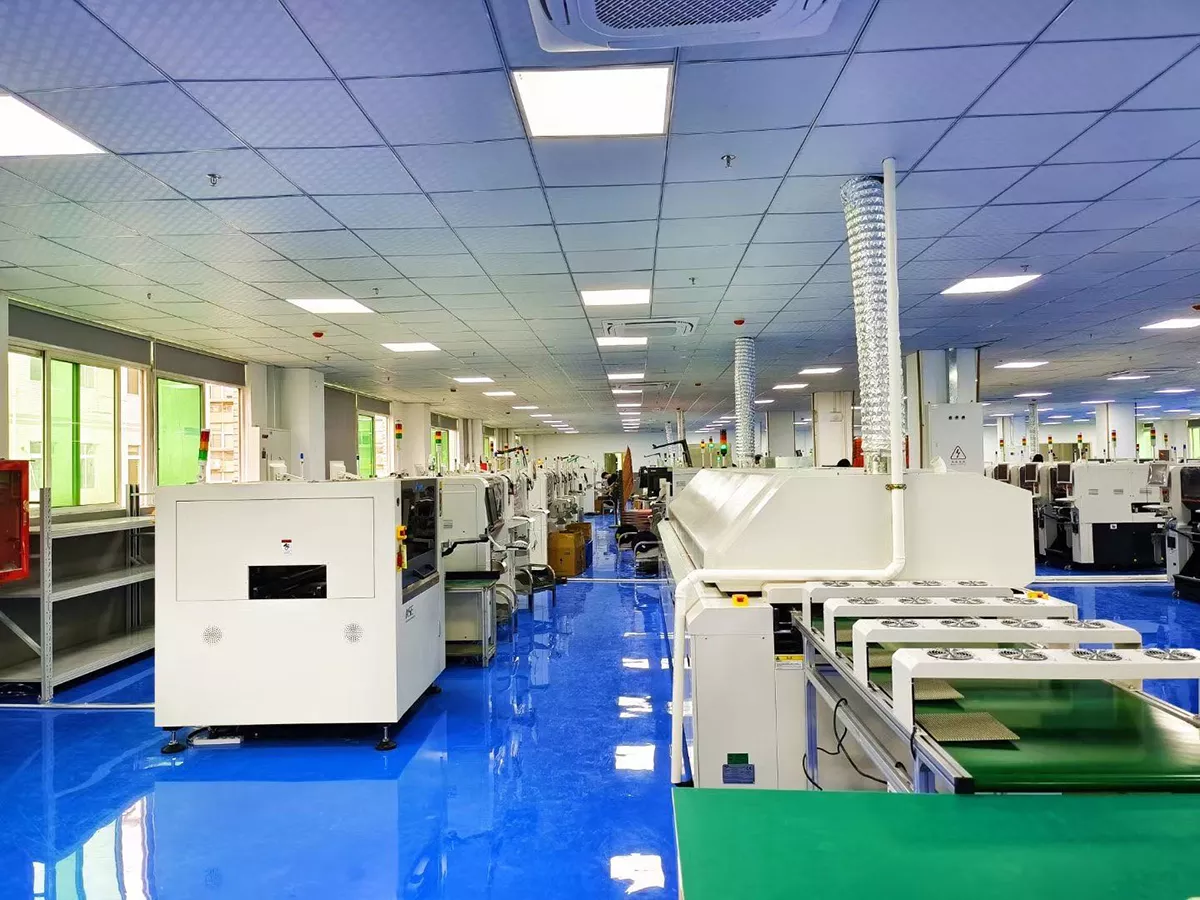
Fast delivery and sufficient production capacity
We have mature and efficient production lines that can produce high-quality LED displays with fast delivery, which is very important for LED display rental projects because many projects require timeliness.
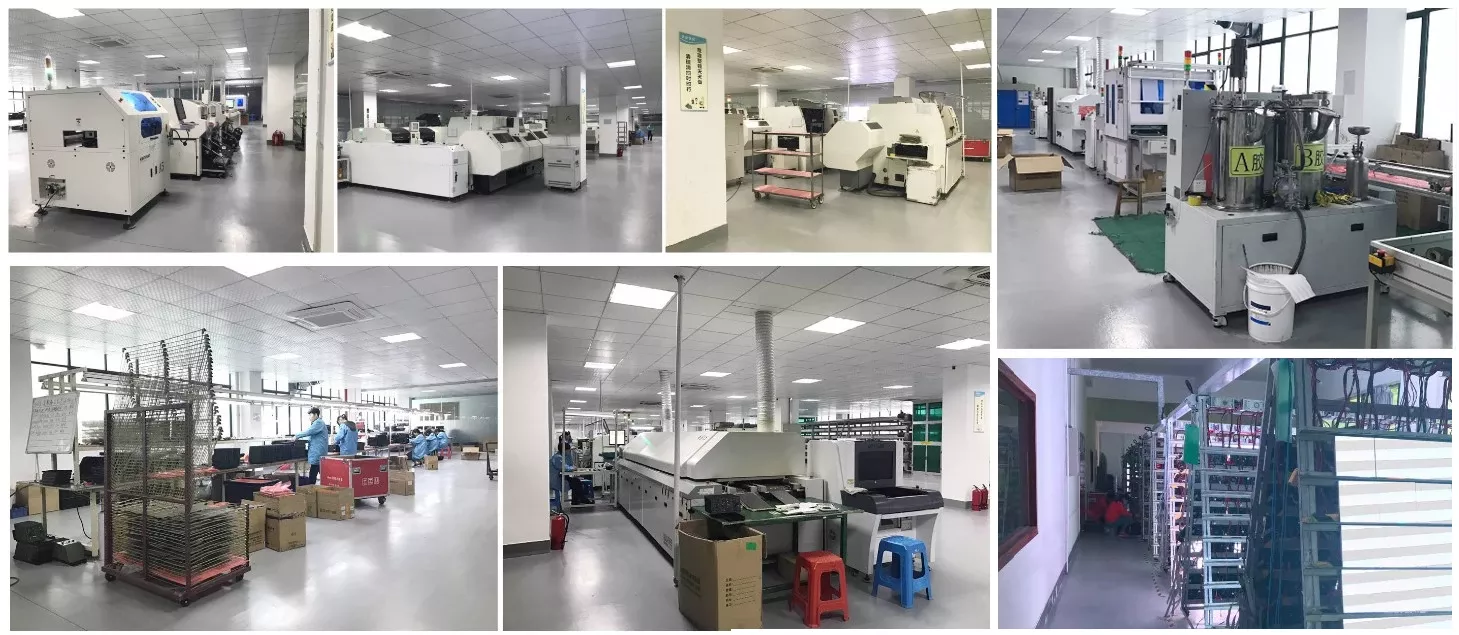

8. Conclusion
As you have learned in this article, LED display modules are stable, reliable, versatile, and can provide excellent visual effects. Its cost effectiveness and energy efficiency make it a smart choice to enhance your brand image or increase your profits!
Chinastar LED is committed to providing customers with high-quality LED display modules and comprehensive service support! Want to buy satisfactory modules at a preferential price? Or do you need a reasonable quote? Contact us today by filling out the simple form to learn more!

Send Us An Message
High-quality products, superb technology

